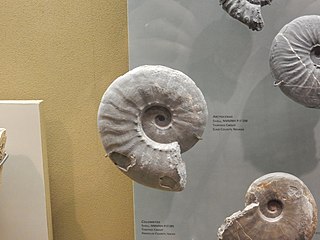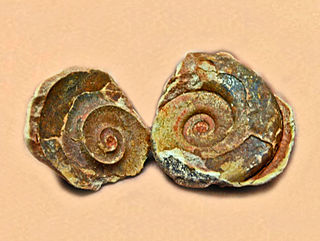
Ammonitida or "True ammonites" are an order of ammonoid cephalopods that lived from the Jurassic through Paleocene time periods, commonly with intricate ammonitic sutures.
Acanthinites is a genus of extinct cephalopods belonging to the ammonoid order Ceratitida described by Mojsisovics in 1893 who established the type species of the group as Acanthinites excelsus. The Shell is involute, compressed; sides arched, converging on narrow venter with a central furrow bordered by low serrated keels. Flanks are covered by numerous spiral rows of tubercles.

Xenodiscus is an extinct genus of ammonoid cephalopod and one of the earliest known ceratites, found in the Upper Permian of northern India and Timor. Xenodiscus is included in the family Xenodiscidae which is part of the ceratite superfamily Xenodiscaceae.
Albanites is a genus of extinct cephalopods belonging to the ammonoid order Ceratitida that lived during the Early Triassic epoch.

Arctoceras is a genus of ceratitid ammonoids from the Lower Triassic with a moderately narrow discoidal shell and ceratitic suture.
Arctomeekoceras is a genus of ammonoids in the order Ceratitida from the Early Triassic, included in the Meekoceratidae; a family characterized by more of less involute, compressed, discoidal forms that are smooth or weakly ornamented and have a ceratitic suture with broad saddles.
Dobrogeites is a genus of ammonoids from the order Ceratitida, included in the family Megaphyllitidae that produced evolute compressed planispiral shells with rounded venters, inner whorls ornamented as in Tirolites, outer whorls smooth, suture with multiple smooth lobes; Initially found in Anisian sediments in Romania.

Ceratitida is an order that contains almost all ammonoid cephalopod genera from the Triassic as well as ancestral forms from the Upper Permian, the exception being the phylloceratids which gave rise to the great diversity of post-Triassic ammonites.
The Noritidae, sometimes spelled Noritidea, is an extinct cephalopod family of belonging to the ammonoid order Ceratitida and superfamily Noritoidea.

Xenodiscoidea, formerly Xenodiscaceae, is a superfamily within the ammonoid order Ceratitida. The superfamily was named by Frech in 1902, presently contains ten families, only one of which was included in the original Otocerataceae of Hyatt, 1900, the remaining having been added.
Xenoceltitidae are evolute, generally ribbed, upper Lower Triassic Ceratitida with ceratitic or goniatitic sutures; formerly included in the Noritaceae but now placed in the Xenodiscaceae.
Paraceltitidae is a family of Middle and Upper Permian cephalopods, that comprise the earliest of the Ceratitida. Paraceltitidids have variably ribbed, discoidally evolute shells with compressed elliptical whorl sections and simple suture lines. Their origin is most likely in the Daraelitidae of the Prolecanitida and they are the apparent source of the Xenodiscidae. All together they lived for some 12 million years, from about 270.6 to about 258 million years ago.
Austrotrachyceras is a genus of ammonite cephalopod, belonging to the order Ceratitida.
The Ophiceratidae is a family in the ammonoid order Ceratitida from the Lower Triassic, previously included in the Otocerataceae but now placed in the Noritiaceae as revised.
Clydonitoidea, formerly Clydonitaceae, is a superfamily in the ammonoid cephalopod order Ceratitida characterized by generally costate and tuberculate shells with smooth, grooved, or keeled venters and sutures that are commonly ceratitic or ammonitic but goniatitic in a few offshoots.
Ceratitoidea, formerly Ceratitaceae, is an ammonite superfamily in order Ceratitida characterized in general by highly ornamented or tuberculate shells with ceratitic sutures that may become goniatitic or ammonitic in some offshoots.
The Tropitidae is a family of Upper Triassic Ammonoidea belonging to the Tropitoidea, a superfamily of the Ceratitida
Sirenites is a genus of ammonoid cephalopods from the Upper Triassic included in the Ceratitida, and type for the trachyceratid subfamily Sirenitinae.

Trachyceras is a genus belonging to the extinct subclass of cephalopods known as ammonites. Specifically it belongs in the order Ceratitida. They are distributed in Afghanistan, Bosnia and Herzegovina, Canada, China, Germany, Hungary, India, Indonesia, Italy, the Russian Federation, Slovenia, United States.
Boreotrachyceras is an extinct genus of ammonite cephalopod, belonging to the order Ceratitida.






